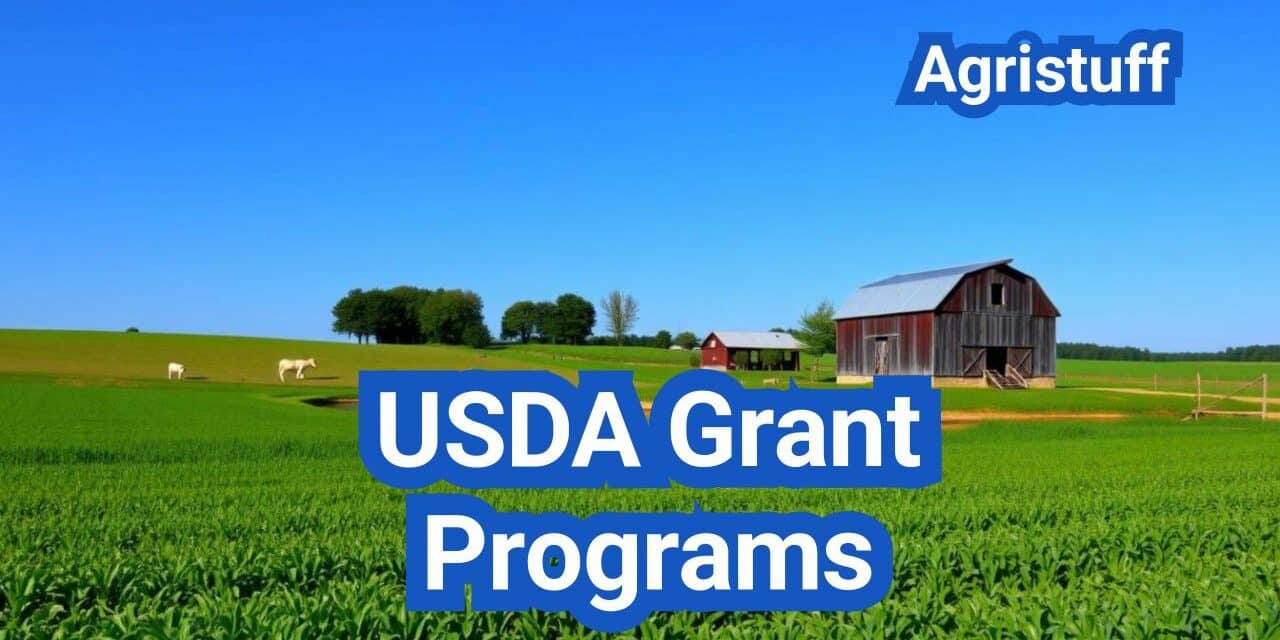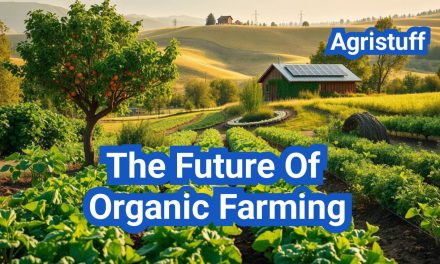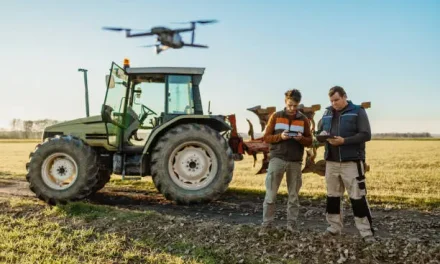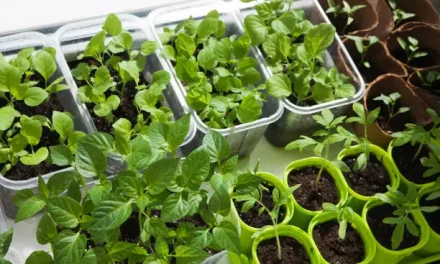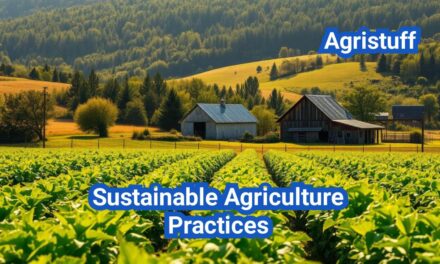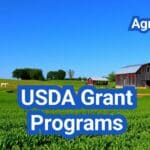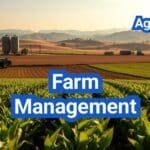The United States Department of Agriculture (USDA) offers various grant programs to support agricultural production, rural development, and community facilities. These programs are designed to provide financial assistance to farmers, small businesses, and rural communities.
Programs such as the Emergency Conservation Program (ECAP), Specialty Crop Block Grant Program (SCBGP), and Environmental Quality Incentives Program (EQIP) are just a few examples of the initiatives available. Understanding these programs is crucial for those seeking funding to improve their agricultural practices, develop rural areas, and enhance community facilities.
Key Takeaways
- The USDA offers various grant programs to support agricultural production and rural development.
- Programs such as ECAP, SCBGP, and EQIP provide financial assistance to farmers and rural communities.
- Understanding the available programs is crucial for securing funding.
- The application process and timelines vary depending on the program.
- Eligibility criteria differ for each grant program.
Understanding USDA Grant Programs and Their Purpose
USDA grants play a crucial role in fostering economic growth and development in rural areas across the United States. These grant programs are designed to address various needs, from agricultural development to community infrastructure improvements.
The Mission Behind USDA Grants
The mission behind USDA grants is to support rural development by providing financial assistance to projects that enhance the quality of life in rural communities. This includes initiatives that promote agricultural productivity, improve rural infrastructure, and foster economic development.
By focusing on these areas, USDA grants aim to create sustainable and thriving rural communities. The grants are tailored to meet the specific needs of rural areas, ensuring that the funding has a meaningful impact.
How USDA Grants Support Rural Development
USDA grants support rural development through various programs that cater to different aspects of rural life. These include grants for agricultural production, rural business development, and community facilities. By providing financial support, USDA grants enable rural communities to undertake projects that might otherwise be unfeasible due to limited resources.
The support provided by USDA grants helps rural communities to grow and develop in a sustainable manner. This, in turn, contributes to the overall economic growth of the region.
Economic Impact of USDA Funding Initiatives
The economic impact of USDA funding initiatives is significant. By investing in rural development projects, USDA grants stimulate economic activity, create jobs, and improve the overall quality of life in rural areas. Studies have shown that USDA grants can have a multiplier effect on the economy, generating additional economic activity beyond the initial investment.
For instance, a USDA grant might support a rural business expansion, leading to the creation of new jobs and increased local spending. This not only benefits the business but also has a positive ripple effect throughout the community.
Types of USDA Grant Programs Available
The USDA offers a diverse range of grant programs to support agricultural development and rural communities. These programs are designed to address various needs, from agricultural production and farm operations to rural business development and community infrastructure.
Agricultural Production and Farm Operation Grants
The USDA provides grants to support agricultural producers, enhancing their ability to maintain and improve farm operations. These grants can be used for a variety of purposes, including farm equipment upgrades, soil conservation, and irrigation improvements. For instance, the Environmental Quality Incentives Program (EQIP) offers financial assistance to farmers to implement conservation practices.
| Grant Program | Purpose | Eligible Applicants |
|---|---|---|
| EQIP | Conservation practices | Farmers, Ranchers |
| Value-Added Producer Grants | Value-added production | Agricultural Producers |
| Farmers Market Promotion Program | Farmers market development | Agricultural Producers, Farmers Markets |
Rural Business and Economic Development Grants
Rural businesses and communities can benefit from USDA grants aimed at economic development. These grants support initiatives such as rural entrepreneurship, business expansion, and job creation. The Rural Business Development Grants program is one example, providing funding for projects that enhance economic development in rural areas.
Community Facilities and Infrastructure Grants
The USDA also offers grants to improve community facilities and infrastructure in rural areas. These grants can be used for projects such as healthcare facilities, public safety equipment, and community centers. The Community Facilities Direct Loan & Grant Program is a key resource for financing these types of projects.
Food Systems and Local Food Promotion Grants
Grants are available to support local food systems and promote regional food economies. These grants can fund initiatives such as farmers market development, local food marketing, and food hub establishment. The Farmers Market and Local Food Promotion Program is designed to support these efforts.
Agricultural Grants for Farmers and Producers

Agricultural grants from the USDA provide critical funding for farmers and producers looking to implement new practices, conserve resources, and promote specialty crops. These grants are designed to support the agricultural community by offering financial assistance for a variety of projects and initiatives.
Value-Added Producer Grants (VAPG)
The Value-Added Producer Grants (VAPG) program is a key initiative that supports farmers and producers in developing value-added products. This grant helps in generating new market opportunities and increasing the profitability of agricultural products.
Through VAPG, recipients can fund projects that enhance the value of their products, such as processing, marketing, and distribution. This not only benefits the farmers but also contributes to the local economy by creating jobs and promoting local products.
Conservation Innovation Grants
Conservation Innovation Grants are designed to stimulate the development and adoption of innovative conservation approaches and technologies. These grants support projects that aim to improve the environment, enhance water quality, and promote sustainable agricultural practices.
By funding innovative conservation projects, the USDA encourages farmers and producers to adopt cutting-edge solutions that benefit both their operations and the environment.
NRCS Environmental Quality Incentives Program (EQIP)
The NRCS Environmental Quality Incentives Program (EQIP) provides financial and technical assistance to farmers and producers to implement conservation practices. EQIP focuses on improving environmental quality by addressing natural resource concerns.
Through EQIP, participants receive support to adopt conservation practices such as soil conservation, water quality improvement, and wildlife habitat enhancement. This program is crucial for promoting environmental stewardship among agricultural producers.
Specialty Crop Block Grant Program
The Specialty Crop Block Grant Program is another significant initiative that supports the specialty crop industry. This program funds projects that enhance the competitiveness of specialty crops, including fruits, vegetables, and nursery crops.
Grants under this program are used for a variety of purposes, such as research, marketing, and education. By promoting specialty crops, the program contributes to the diversity and sustainability of the agricultural sector.
Rural Development Grant Opportunities
With a range of programs available, rural development grant opportunities from the USDA can significantly impact local infrastructure and businesses. These grants are designed to support the unique needs of rural communities, promoting economic growth and improving the quality of life for residents.
Rural Energy for America Program (REAP) Grants
The Rural Energy for America Program (REAP) provides grants to agricultural producers and rural small businesses to implement energy-efficient systems and renewable energy projects. This program aims to reduce energy costs and consumption, promoting sustainability in rural areas.
Key Benefits of REAP Grants:
- Financial assistance for energy audits and renewable energy systems
- Support for energy-efficient equipment and systems
- Opportunities for rural businesses and agricultural producers to reduce energy costs
Community Facilities Direct Loan & Grant Program
The Community Facilities Direct Loan & Grant Program offers funding for essential community facilities in rural areas, including healthcare facilities, public buildings, and educational facilities. This program helps ensure that rural communities have access to necessary services and infrastructure.
Program Highlights:
| Eligible Facilities | Funding Options | Benefits |
|---|---|---|
| Healthcare facilities, public buildings, educational facilities | Direct loans and grants | Improved access to essential services, enhanced community infrastructure |
Rural Business Development Grants
Rural Business Development Grants support the growth and development of rural businesses, providing funding for projects that create jobs and stimulate local economies. These grants can be used for a variety of purposes, including business incubation, training, and technical assistance.
Distance Learning and Telemedicine Grants
The Distance Learning and Telemedicine Grant Program funds projects that provide educational and healthcare resources to rural communities through advanced telecommunications technologies. This program helps bridge the gap in access to quality education and healthcare services in rural areas.
Program Objectives:
- Enhance access to education and healthcare through technology
- Support rural economic development through improved telecommunications infrastructure
- Foster innovation in distance learning and telemedicine
USDA Grant Eligibility Requirements
Understanding the eligibility requirements for USDA grants is crucial for a successful application. The USDA has established specific criteria to ensure that grant funds are allocated to projects that align with its mission and objectives.
General Qualification Criteria
To qualify for USDA grants, applicants must meet certain general criteria. These include being a legal entity, such as a business, non-profit organization, or individual, and having the legal capacity to enter into a grant agreement. Applicants must also have a satisfactory record of performance, financial management, and compliance with relevant laws and regulations.
Key qualification criteria include:
- Legal entity status
- Satisfactory performance and financial management record
- Compliance with relevant laws and regulations
Geographic Eligibility Considerations
Geographic eligibility is a critical factor in determining eligibility for USDA grants. Many USDA grant programs are targeted towards rural areas or specific regions. Applicants must ensure that their project is located in an eligible area.
Business Size and Structure Requirements
The USDA has specific requirements regarding business size and structure for certain grant programs. For example, some grants are limited to small businesses or microentrepreneurs. Applicants must review the specific requirements for each grant program to determine if their business size and structure are eligible.
| Business Size | Number of Employees | Annual Revenue |
|---|---|---|
| Small Business | Fewer than 500 | Less than $7 million |
| Microentrepreneur | Fewer than 10 | Less than $1 million |
Financial Standing and Matching Fund Requirements
Applicants must also demonstrate financial stability and meet matching fund requirements for certain USDA grants. The USDA typically requires applicants to contribute a portion of the project costs, known as matching funds.
“The USDA’s grant programs are designed to support projects that promote rural development and agricultural innovation. To be eligible, applicants must demonstrate a clear understanding of the project’s financial requirements and a commitment to meeting matching fund obligations.” – USDA Rural Development
By understanding and meeting these eligibility requirements, applicants can increase their chances of securing USDA grant funding for their projects.
Special USDA Grants for Underserved Groups
Underserved communities in agriculture can benefit from specialized USDA grants designed to promote diversity and inclusion. These grants aim to support individuals and groups who face unique challenges in the agricultural sector.
USDA Grants for Women in Agriculture
Women play a crucial role in agriculture, and the USDA recognizes their contributions through various grant programs. These grants support women in agriculture by providing funding for projects that enhance their participation and success in the industry.
Beginning Farmer and Rancher Development Program
The Beginning Farmer and Rancher Development Program (BFRDP) is a USDA initiative that provides grants to support new farmers and ranchers. This program focuses on education, training, and outreach to help beginning farmers succeed in their agricultural endeavors.
The BFRDP offers various resources, including workshops, mentorship programs, and curriculum development, to equip new farmers with the skills and knowledge they need to thrive.
USDA Grants for Seniors and Veterans
The USDA also offers grants to support seniors and veterans in agriculture. These grants recognize the valuable contributions these individuals make to the agricultural community and provide them with the resources they need to continue their work.
Socially Disadvantaged Groups Funding Opportunities
Socially disadvantaged groups, including minority farmers and ranchers, can access USDA grants designed to address the unique challenges they face. These funding opportunities aim to promote equity and inclusion in the agricultural sector.
The following table summarizes the key features of these USDA grant programs for underserved groups:
| Grant Program | Target Group | Primary Focus |
|---|---|---|
| USDA Grants for Women in Agriculture | Women farmers and ranchers | Enhancing women’s participation in agriculture |
| Beginning Farmer and Rancher Development Program | New farmers and ranchers | Education, training, and outreach for beginning farmers |
| USDA Grants for Seniors and Veterans | Seniors and veterans in agriculture | Supporting the continued contributions of seniors and veterans |
| Socially Disadvantaged Groups Funding Opportunities | Minority farmers and ranchers | Promoting equity and inclusion in agriculture |
These USDA grant programs demonstrate the agency’s commitment to supporting diverse groups within the agricultural community. By providing targeted funding and resources, the USDA helps to create a more inclusive and equitable agricultural sector.
Small Business USDA Grant Programs

For small businesses looking to thrive in rural communities, the USDA offers a range of grant opportunities. These programs are designed to support business growth, innovation, and development in rural America.
Small Business Innovation Research (SBIR) Grants
The SBIR program is a competitive funding opportunity that encourages small businesses to engage in research and development (R&D) that has the potential for commercialization. The USDA’s SBIR program focuses on agricultural and food-related projects, providing funding for innovative ideas that can drive economic growth.
Key benefits of SBIR grants include:
- Funding for high-risk, high-reward research projects
- Opportunities for commercialization and market expansion
- Support for innovative technologies and processes
Rural Microentrepreneur Assistance Program
The Rural Microentrepreneur Assistance Program (RMAP) provides funding to support microentrepreneurs in rural areas. This program offers grants to organizations that provide training, technical assistance, and other support services to microenterprises.
The goals of RMAP include:
- Promoting entrepreneurship in rural communities
- Supporting the development of microenterprises
- Fostering economic growth and job creation
Farmers Market and Local Food Promotion Program
The Farmers Market and Local Food Promotion Program (FMLFPP) supports the development of local food systems by providing grants to projects that improve access to local foods. This program funds initiatives such as farmers’ markets, community-supported agriculture (CSA) programs, and other local food infrastructure.
Examples of FMLFPP projects include:
- Developing new farmers’ markets or expanding existing ones
- Creating online platforms for local food sales
- Implementing food hubs or other local food distribution systems
Rural Cooperative Development Grant Program
The Rural Cooperative Development Grant (RCDG) program provides funding to support the development of cooperatives in rural areas. This program aims to promote economic development and improve the quality of life for rural residents by supporting cooperative businesses.
The RCDG program supports:
- Cooperative development and business planning
- Technical assistance and training for cooperatives
- Market research and analysis for cooperative businesses
Step-by-Step Guide to Applying for USDA Grants

To navigate the USDA grant application process effectively, it’s essential to understand the various requirements and procedures involved. The process can be complex, but breaking it down into manageable steps can simplify the task.
Creating a Grants.gov Workspace Account
The first step in applying for a USDA grant is to create a workspace account on Grants.gov. This platform is the central hub for all federal grant applications, including those offered by the USDA.
To create an account:
- Visit Grants.gov and register for a workspace account.
- Provide the required information, including your name, email address, and password.
- Verify your email address through the confirmation link sent by Grants.gov.
Obtaining Your SAM UEI Registration
A critical step in the application process is obtaining a Unique Entity Identifier (UEI) through the System for Award Management (SAM). The SAM UEI is a 12-character alphanumeric identifier assigned to entities that work with the federal government.
The process involves:
- Registering or updating your entity’s information in SAM.gov.
- Obtaining a UEI, which replaces the previously used DUNS number.
- Ensuring your SAM registration is active and up-to-date.
Gathering Required Documentation
Applicants must gather and prepare various documents, including financial statements, project proposals, and other supporting materials. The specific requirements can vary depending on the grant program.
A detailed table outlining common documentation requirements is provided below:
| Document Type | Description | Required For |
|---|---|---|
| Financial Statements | Balance sheets, income statements, and cash flow statements. | Most grant programs. |
| Project Proposal | A detailed description of the project, including goals and timelines. | All grant applications. |
| Business Plan | A comprehensive plan outlining business strategies and financial projections. | Rural Business Development Grants. |
Navigating the USDA Grant Portal
The USDA grant portal is a web-based platform that allows applicants to search for and apply for grant opportunities. To navigate this portal effectively, applicants should:
- Use the search function to identify relevant grant opportunities.
- Carefully review the eligibility criteria and application requirements for each grant.
- Follow the instructions provided for submitting an application.
By following these steps and understanding the requirements, applicants can improve their chances of securing a USDA grant.
Preparing a Competitive USDA Grant Application

Preparing a competitive USDA grant application involves a strategic approach to showcasing the project’s value and feasibility. To achieve this, applicants must focus on several key elements that make their proposal stand out.
Developing a Strong Project Narrative
A strong project narrative is the backbone of any successful grant application. It should clearly articulate the project’s goals, objectives, and the problems it aims to solve. When crafting the narrative, applicants should ensure that it is concise, yet comprehensive, providing a compelling case for why the project is necessary and how it aligns with the USDA’s grant objectives.
Key components of a strong project narrative include:
- A clear statement of the project’s goals and objectives
- A detailed description of the problem or need being addressed
- An explanation of how the project will be implemented and managed
- An overview of the expected outcomes and impacts
Creating Realistic Budgets and Financial Projections
Creating a realistic budget and financial projections is crucial for demonstrating the project’s feasibility and financial management. The budget should be detailed, including all costs associated with the project, and should align with the project’s objectives.
Best practices for budget creation include:
- Ensuring all costs are accounted for, including personnel, equipment, and operational expenses
- Providing a detailed breakdown of how funds will be used
- Justifying the budget in the context of the project’s goals and expected outcomes
Demonstrating Project Feasibility and Impact
Demonstrating the project’s feasibility and potential impact is essential for a competitive application. This involves providing evidence that the project can be successfully implemented and that it will achieve its stated objectives.
| Feasibility Factors | Description | Impact Indicators |
|---|---|---|
| Technical Capability | Assessing the team’s technical skills and experience | Increased efficiency or productivity |
| Financial Management | Evaluating the budget and financial planning | Cost savings or effective resource allocation |
| Operational Planning | Reviewing the project timeline and milestones | Timely completion and achievement of milestones |
Addressing Evaluation Criteria Effectively
Understanding and addressing the evaluation criteria is critical for a successful application. Applicants should carefully review the criteria and ensure that their proposal directly addresses each point.
Tips for addressing evaluation criteria:
- Carefully read and understand the evaluation criteria
- Tailor the application to directly address each criterion
- Provide clear and concise responses to each evaluation question
USDA Grant Application Timelines and Deadlines
To successfully secure USDA grant funding, applicants must be aware of the specific application timelines and deadlines. The USDA releases grant opportunities throughout the year, each with its own cycle and requirements.
Annual Application Cycles for Major Programs
The USDA operates on annual application cycles for many of its major grant programs. For instance, the Value-Added Producer Grants (VAPG) and Business and Industry (B&I) Guaranteed Loans typically have annual application windows. Understanding these cycles is crucial for planning and preparing a competitive application.
- VAPG: Usually announced in the spring, with applications due a few months later.
- B&I Guaranteed Loans: Often have a continuous application process, but with specific review periods.
Seasonal Funding Opportunities
Some USDA grant programs are designed to address seasonal needs or opportunities. For example, the Emergency Watershed Protection Program may have application windows tied to natural disaster occurrences.
- Identify the specific seasonal or emergency funding opportunities relevant to your project.
- Prepare your application materials in advance to meet the potentially short application windows.
Managing Application Submission Deadlines
Meeting application submission deadlines is critical. The USDA uses an online portal, Grants.gov, for many of its grant applications. Applicants should:
- Create an account and familiarize themselves with the portal well in advance of deadlines.
- Ensure all required documents are prepared and compliant with USDA requirements.
- Submit applications early to avoid last-minute technical issues.
Post-Submission Timeline Expectations
After submitting a USDA grant application, applicants should be aware of the subsequent timeline:
| Stage | Timeline | Description |
|---|---|---|
| Application Review | Several weeks to months | USDA reviews applications for completeness and eligibility. |
| Technical Review | Varies | Applications are reviewed for merit and alignment with program goals. |
| Funding Decision | Several months | USDA makes final funding decisions based on review outcomes. |
Understanding these timelines and deadlines is essential for planning and successfully securing USDA grant funding. Applicants are advised to regularly check the USDA and Grants.gov websites for the most current information on grant opportunities and application deadlines.
Securing Technical Assistance for Your USDA Grant

The USDA grant application process can be daunting, but applicants can access numerous technical assistance options to guide them through.
Technical assistance is crucial for navigating the complexities of USDA grant applications. It provides applicants with the necessary support to ensure their proposals are competitive and compliant with USDA requirements.
USDA Rural Development Office Support
The USDA Rural Development Office offers significant support to applicants. Their offices are located throughout the country and provide personalized assistance.
- Guidance on eligibility requirements
- Help with application preparation
- Information on available funding opportunities
Applicants can benefit from the expertise of USDA Rural Development staff, who can offer insights into the review process and provide tips for a successful application.
Extension Services and University Resources
Extension services and universities are valuable resources for technical assistance. They often have experts familiar with USDA grant programs.
These resources can provide:
- Workshops and training sessions on grant writing
- One-on-one consultations for application review
- Access to databases and research materials relevant to the grant proposal
Nonprofit and Community Organization Assistance
Many nonprofit and community organizations specialize in assisting applicants with USDA grants. They offer a range of services, including:
- Grant writing workshops
- Application review and editing
- Project planning and development
These organizations often have experience working with USDA programs and can provide valuable insights.
Professional Grant Writing Services
For those who need specialized assistance, professional grant writing services can be a viable option. These services can help with:
- Developing a compelling project narrative
- Creating detailed budgets and financial projections
- Ensuring compliance with USDA application requirements
When selecting a grant writing service, it’s essential to choose a reputable provider with experience in USDA grants.
| Technical Assistance Resource | Description | Benefits |
|---|---|---|
| USDA Rural Development Office | Personalized assistance from USDA staff | Guidance on eligibility, application preparation, and funding opportunities |
| Extension Services and Universities | Expert advice and resources from extension services and universities | Workshops, one-on-one consultations, and access to research materials |
| Nonprofit and Community Organizations | Specialized assistance from nonprofits and community organizations | Grant writing workshops, application review, and project planning |
| Professional Grant Writing Services | Expertise in grant writing from professional services | Compelling project narratives, detailed budgets, and compliance assurance |
Common Mistakes to Avoid When Applying for USDA Grants

The pursuit of USDA grant funding is a competitive endeavor that requires careful navigation to avoid common mistakes. Applicants must be diligent in their preparation to ensure their proposals are comprehensive and compelling.
Incomplete Applications and Missing Documentation
One of the most significant errors applicants make is submitting incomplete applications or failing to include necessary documentation. This oversight can lead to immediate disqualification. To avoid this, it’s crucial to:
- Carefully review the application checklist provided by the USDA.
- Ensure all required forms are completed accurately and in full.
- Attach all necessary supporting documents, such as financial statements and project plans.
Misalignment with Program Objectives
Another critical mistake is failing to align the grant proposal with the specific objectives of the USDA program. Applicants should:
- Thoroughly research the program’s goals and priorities.
- Tailor their project narrative to demonstrate how their proposal aligns with these objectives.
- Use language from the program’s solicitation to highlight the relevance of their project.
Budget and Timeline Errors
Errors in budgeting and timeline projections can undermine the credibility of an application. To avoid this, applicants should:
- Develop a detailed and realistic budget that aligns with the project’s objectives.
- Ensure that the timeline is feasible and includes milestones and deadlines.
- Provide justification for budgetary items to demonstrate their necessity.
Failure to Follow Submission Instructions
Not adhering to the submission guidelines can result in an application being rejected without review. Applicants must:
- Follow the submission instructions to the letter.
- Use the correct submission portal or method as specified by the USDA.
- Verify that all components of the application are included and correctly formatted.
To further illustrate the importance of avoiding these mistakes, consider the following table that outlines common errors and their potential consequences:
| Common Mistake | Potential Consequence |
|---|---|
| Incomplete Application | Immediate Disqualification |
| Misalignment with Program Objectives | Low Review Score |
| Budget and Timeline Errors | Reduced Funding or Rejection |
| Failure to Follow Submission Instructions | Rejection Without Review |
By being aware of these common mistakes and taking steps to avoid them, applicants can significantly enhance their chances of securing USDA grant funding.
Success Stories: How Recipients Used USDA Grant Funding

Success stories from USDA grant recipients highlight the program’s impact on rural development and agricultural innovation. These stories demonstrate how funding has been used to drive growth, improve sustainability, and enhance community well-being.
Small Farm Transformation Case Studies
Several small farms have undergone significant transformations thanks to USDA grant funding. For instance, a family-owned farm in rural Ohio received a Value-Added Producer Grant to develop an organic produce line, which increased their revenue by 30% within a year.
“The USDA grant was a game-changer for our farm. It allowed us to diversify our products and reach new markets, ensuring our long-term sustainability.” – Jane Doe, Farm Owner
Another example is a farm in California that used a Conservation Innovation Grant to implement advanced irrigation systems, reducing water consumption by 25% while maintaining crop yields.
Rural Business Growth Through USDA Support
USDA grants have also been pivotal in fostering rural business growth. A rural town in Texas utilized a Rural Business Development Grant to establish a community-owned processing facility, creating jobs and stimulating local economic activity.
The town’s economic development officer noted, “The USDA grant helped us overcome initial financial hurdles and attract private investment, transforming our local economy.”
Community Development Project Outcomes
Community development projects funded by USDA grants have led to significant improvements in rural infrastructure and services. For example, a rural community in Alaska received funding for a Community Facilities Direct Loan & Grant Program to upgrade their healthcare facility, enhancing healthcare access for residents.
- Improved healthcare services
- Enhanced community facilities
- Increased local economic activity
Innovation and Sustainability Achievements
USDA grant recipients have made notable achievements in innovation and sustainability. A cooperative of farmers in Oregon used a Rural Cooperative Development Grant to develop a renewable energy project, reducing their carbon footprint and energy costs.
The cooperative’s manager stated, “The USDA grant enabled us to invest in renewable energy, improving our sustainability and setting an example for other rural cooperatives.”
These success stories underscore the effectiveness of USDA grant programs in driving positive change in rural America, from small farm transformations to broader community development initiatives.
Alternative Funding Options Beyond USDA Grants
Agricultural projects can benefit from a diverse range of funding options beyond traditional USDA grants. While USDA grants are a significant source of financial support, exploring alternative funding sources can provide additional resources for growth and innovation.
USDA Loan Programs and Guarantees
Beyond grants, the USDA offers various loan programs and guarantees that can support agricultural businesses and initiatives. These loan programs can provide necessary capital for projects that may not qualify for grants or need additional funding.
- Direct Loans: The USDA offers direct loans to farmers, ranchers, and rural businesses that can’t obtain credit elsewhere.
- Guaranteed Loans: These loans are provided by commercial lenders, with the USDA guaranteeing a portion of the loan, reducing the risk for lenders.
According to a USDA report, “In 2022, the USDA provided over $1.5 billion in direct loans and $7.5 billion in guaranteed loans to support agricultural producers and rural businesses.”
“The USDA’s loan programs are crucial for supporting rural development and agricultural innovation, providing access to capital for businesses and farmers who might otherwise struggle to secure funding.”
| Loan Program | Purpose | Maximum Loan Amount |
|---|---|---|
| Direct Farm Ownership Loan | Purchase or improve farmland | $600,000 |
| Guaranteed Farm Loan | Support farm operations | $1,399,000 |
| Business and Industry Loan Guarantee | Support rural businesses | $10,000,000 |
State and Local Agricultural Funding Sources
State and local governments also offer funding opportunities for agricultural projects. These can include grants, loans, and tax incentives aimed at promoting local agricultural development.
For instance, the California Department of Food and Agriculture offers various grant programs to support local agriculture, including the California Agricultural Leadership Foundation Grants.
Private Foundation Grants for Agriculture
Private foundations play a significant role in supporting agricultural initiatives. These foundations often focus on specific areas such as sustainable agriculture, organic farming, and rural development.
- The National Agricultural Library provides resources and information on private foundation grants for agriculture.
- Foundations like the W.K. Kellogg Foundation and the Ford Foundation have programs dedicated to supporting agricultural projects.
Crowdfunding and Community-Supported Agriculture
Crowdfunding and community-supported agriculture (CSA) models are innovative ways to fund agricultural projects. These approaches allow farmers to raise capital directly from their community or customers.
Platforms like Kickstarter and Indiegogo are popular for crowdfunding agricultural projects, while CSA models enable consumers to invest in local farms by purchasing shares of the produce.
By exploring these alternative funding options, agricultural businesses and initiatives can access a broader range of financial resources to support their growth and success.
Maximizing Your Chances for USDA Grant Success
Maximizing your chances for USDA grant success requires a comprehensive understanding of the various grant programs available, as well as careful preparation and planning. By familiarizing yourself with the different types of USDA grants, such as those for agricultural production, rural development, and community facilities, you can identify the most suitable opportunities for your needs.
A well-prepared application is crucial to securing USDA grant funding. This involves developing a strong project narrative, creating realistic budgets and financial projections, and demonstrating project feasibility and impact. By following the guidelines outlined in this article and leveraging available resources, such as technical assistance from USDA Rural Development offices and professional grant writing services, you can increase your chances of USDA grant success.
Ultimately, maximizing your chances for USDA grant success requires a strategic approach, combining a deep understanding of the grant programs with effective application preparation and submission. By doing so, you can secure the funding needed to drive your projects forward and achieve your goals.
FAQ
What is the purpose of USDA grant programs?
The USDA grant programs aim to support agricultural production, rural development, and community facilities, promoting rural development, improving agricultural practices, and supporting community facilities.
Who is eligible for USDA grants?
Eligibility varies by program, but generally includes farmers, small businesses, and rural communities. Specific eligibility requirements are outlined in each grant program.
What types of USDA grant programs are available?
The USDA offers various grant programs, including those for agricultural production, rural business development, community facilities, and food systems.
How do I apply for a USDA grant?
To apply, create a Grants.gov workspace account, obtain SAM UEI registration, gather required documentation, and navigate the USDA grant portal.
What are the most common mistakes to avoid when applying for USDA grants?
Common mistakes include incomplete applications, misalignment with program objectives, budget and timeline errors, and failure to follow submission instructions.
Are there special USDA grants for underserved groups?
Yes, the USDA offers grants for women in agriculture, beginning farmers, seniors, veterans, and socially disadvantaged groups.
What is the Rural Energy for America Program (REAP) grant?
The REAP grant supports rural energy efficiency and renewable energy projects, promoting energy independence and reducing energy costs.
Can small businesses apply for USDA grants?
Yes, small businesses can apply for USDA grants, including the Small Business Innovation Research (SBIR) grants and the Rural Microentrepreneur Assistance Program.
How do I prepare a competitive USDA grant application?
To prepare a competitive application, develop a strong project narrative, create realistic budgets and financial projections, demonstrate project feasibility and impact, and address evaluation criteria effectively.
What are the USDA grant application timelines and deadlines?
Application timelines and deadlines vary by program, with some having annual application cycles and others offering seasonal funding opportunities.
Where can I find technical assistance for USDA grants?
Technical assistance is available through the USDA Rural Development Office, Extension Services, university resources, nonprofit organizations, and professional grant writing services.
Are there alternative funding options beyond USDA grants?
Yes, alternative funding options include USDA loan programs, state and local agricultural funding sources, private foundation grants, and crowdfunding.
Conclusion of: USDA Grant Programs
Introduction: why a USDA grant matters for U.S. agriculture
If you run a farm, food venture, or rural nonprofit in the United States, a USDA grant can be the difference between a great idea and a funded project—covering everything from local food marketing to energy efficiency and community facilities. NIFA overview of USDA grants
What a USDA grant is—and what it isn’t
A USDA grant is non-repayable federal assistance tied to specific objectives and rules; it is different from USDA loans and also different from cost-share programs like EQIP that reimburse part of your costs, so read each opportunity’s eligibility and terms closely. Grants.gov: how federal grants work
Who typically qualifies for a USDA grant
Most USDA grant programs target eligible nonprofits, producer groups, small businesses, tribes, cooperatives, state agencies, and rural public bodies; individual for-profit farms can qualify in programs like Value-Added Producer Grants (VAPG) and REAP, while universities and nonprofits are common leads for research and training grants. USDA Rural Development: programs & services
Where to find the right USDA grant for your idea
To find a USDA grant that matches your project, start with the agency that best fits your work—Rural Development for rural businesses and facilities, AMS for local/regional food systems, NIFA for research and training, NRCS for conservation incentives—and use Grants.gov to track open funding opportunities. USDA AMS: grants & opportunities
Value-Added Producer Grants (VAPG): turning products into revenue
If you’re developing a branded cheese, milling grains, or bottling orchard cider, a USDA grant under VAPG can fund planning or working capital to bring your value-added product to market—eligible applicants include agricultural producers, producer groups, producer-based businesses, and co-ops. VAPG: program details & eligibility
REAP: energy savings and renewables on the farm
For efficiency upgrades (e.g., grain-dryer motors) or renewables (e.g., solar for poultry houses), the REAP USDA grant helps agricultural producers and rural small businesses cut costs and add clean energy capacity, with competitive scoring and a required match. REAP grants: official page
REAP timelines you should actually plan around
Because a USDA grant like REAP is highly subscribed, keep an eye on official application windows and any pauses announced by Rural Development—timing affects your project schedule and equipment quotes, especially in late-summer and fall cycles. USDA RD stakeholder announcement (application pause dates)
LAMP umbrella: FMPP, LFPP, and RFSP for regional food systems
If you sell locally or build food-system infrastructure, the LAMP family offers a USDA grant track for direct-to-consumer markets (FMPP), intermediated value chains (LFPP), and regional partnerships (RFSP), each with clear eligibility, match, and narrative requirements. AMS announcement: LAMP FY2025
Farmers Market Promotion Program (FMPP) deadlines
Farmers markets, CSAs, and food hubs often pursue the FMPP USDA grant for outreach, SNAP equipment, and promotion—watch for the annual spring notice and hard deadline (e.g., June 27 in 2025) and build a realistic, metrics-based work plan. FMPP: FY2025 program & due date
Local Food Promotion Program (LFPP): intermediated supply chains
Distributors, aggregators, mobile markets, and cold-chain projects can use the LFPP USDA grant to strengthen regional supply chains serving institutions and retailers, with similar timelines and application structure to FMPP each year. LFPP: FY2025 program & due date
Regional Food System Partnerships (RFSP): multi-sector collaboration
For cross-sector planning and implementation, the RFSP USDA grant funds partnerships that align agencies, nonprofits, and businesses around regional food-system gaps—successful applications clearly show roles, milestones, and outcome metrics. RFSP: FY2025 program & due date
Specialty Crop Block Grants (SCBGP): apply through your state
If your project supports fruits, vegetables, tree nuts, or nursery crops, the SCBGP USDA grant flows to states first; you then apply to your state department of agriculture during its own competitive window, so track both USDA and state timelines. SCBGP: how to apply via your state
NRCS EQIP & CSP: not a USDA grant—but very real money
EQIP and CSP aren’t a USDA grant—they’re cost-share payments for conservation practices with continuous signup and state-specific ranking dates; many farms pair conservation dollars with other grants to round out a project budget. NRCS: program ranking dates
Conservation Innovation Grants (CIG): piloting conservation tech
For producers and partners testing new practices or tech, the CIG USDA grant supports on-farm innovation with a required non-federal match and competitive scoring tied to measurable conservation outcomes. NRCS CIG/EQIP info & state links
SBIR/STTR: R&D grants for agtech and food innovation
Small businesses developing sensors, software, biologics, or processing innovations can tap the SBIR/STTR USDA grant pathway—Phase I supports feasibility (with set budgets and durations) and can lead to a larger Phase II commercialization award. USDA NIFA SBIR/STTR: program information
Who qualifies for SBIR/STTR
To win an SBIR/STTR USDA grant, the applicant must be a U.S. small business; for SBIR, the project director’s primary employment must be with the company during the award, while STTR formalizes collaboration with a research institution. SBIR/STTR: eligibility rules
Beginning Farmer and Rancher Development Program (BFRDP)
New-farmer training organizations often lead this USDA grant for education, mentoring, and technical assistance—individual farms are typically partners or beneficiaries, while nonprofits, colleges, and cooperative extensions serve as applicants. BFRDP: program overview
GusNIP: nutrition incentives and produce prescriptions
Community health and food-access initiatives can leverage the GusNIP USDA grant to match SNAP purchases of fruits and vegetables or prescribe produce via clinics—government agencies and nonprofits are primary applicants. GusNIP: program page
Community Facilities: essential rural services
For rural towns and tribes, the Community Facilities USDA grant helps build or improve essential buildings and equipment—think clinics, fire stations, or food distribution facilities—often paired with low-interest loans. Community Facilities: program page
Distance Learning & Telemedicine (DLT) for rural connectivity
Hospitals, schools, and libraries can use the DLT USDA grant to purchase equipment and services that expand telehealth and remote learning across rural communities—an especially strong fit when food-system training needs broadband delivery. DLT Grants: official page
Organic Certification Cost Share (OCCSP): not a grant, still money
While OCCSP isn’t a traditional USDA grant, it reimburses part of your organic certification fees—pairing this reimbursement with other grants can make a multi-year organic transition more affordable. FSA: Organic Certification Cost Share
Step 1 to apply: get a UEI and register in SAM.gov
Before applying for any USDA grant, get a free Unique Entity ID (UEI) and complete (or renew) your SAM.gov entity registration; DUNS is retired and UEI is now required across federal assistance. SAM.gov: UEI & entity registration
Step 2 to apply: set up Grants.gov and use Workspace
Grants.gov’s Workspace lets your team collaborate on forms, manage roles, and submit a compliant USDA grant package; be sure your SAM registration is active or the “Sign & Submit” button will remain disabled. Grants.gov Workspace: overview
Step 3 to apply: read the RFA and follow the checklist
Every USDA grant has an RFA (Request for Applications) with the only rules that matter—scope, scoring, match, page limits, attachments, and naming conventions—so build your narrative, budget, match letters, and milestones to match the rubric. NIFA Grants Application Guide
Timing and cycles you can plan on
Many USDA grant windows recur annually: AMS LAMP programs typically announce in spring; NRCS conservation funding is continuous with state batching dates; Rural Development posts NOFAs/NOSAs throughout the year—subscribe and plan 8–12 weeks to assemble a strong package. USDA RD: funding opportunity notices
Match funding: what reviewers look for
Several USDA grant programs require non-federal match (e.g., VAPG often 1:1; CIG match; MPPEP 50% cost share), so secure written match commitments early and align your budget categories with what’s allowable. USDA MPPEP: Phase 3 FAQ (cost share)
Strengthen your narrative with evidence and partners
Great USDA grant narratives quantify need, cite demand data, include letters of support, and specify roles; AMS shares webinars and scoring matrices that reveal exactly how reviewers differentiate good from great. AMS: grant applicant webinars
Avoid scams and misinformation
There is no fee to apply for a USDA grant, and you never have to pay to “unlock” federal money—if someone guarantees funding for a fee, walk away and rely on Grants.gov and agency pages for alerts and training. Grants.gov: grant fraud & scams
Get local help early
To make your USDA grant more competitive, contact your USDA Service Center (NRCS/FSA) or your RD State Office early for program fit, timelines, and documentation checklists; staff can clarify eligibility and connect you with technical assistance. USDA Service Center Locator
Final thought
Whether you’re upgrading a milking parlor, launching a mobile market, or piloting climate-smart tech, there is likely a USDA grant designed to help—just start registrations now, track deadlines, line up your match, and write to the scoring criteria. USDA grants portal (start here)
Sources & References
- Farmers Market Promotion Program
- Local Food Promotion Program
- Regional Food System Partnerships
- Specialty Crop Block Grant Program
- Value-Added Producer Grants (VAPG)
- NRCS Ranking Dates (EQIP/CSP)
- USDA NIFA SBIR/STTR Program Information
- Beginning Farmer & Rancher Development Program
- GusNIP (Nutrition Incentive & Produce Prescription)
- Community Facilities Grants
- Distance Learning & Telemedicine Grants
- Organic Certification Cost Share Program (OCCSP)
- SAM.gov: UEI & Registration
- Grants.gov Workspace
- AMS Grant Webinars & Applicant Training
- Grants.gov: Grant Fraud & Scams

